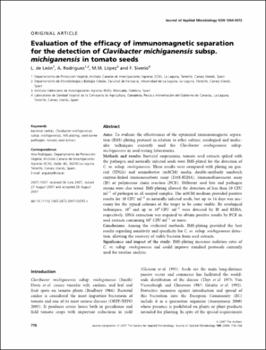Evaluation of the efficacy of immunomagnetic separation for the detection of Clavibacter michiganensis subsp. michiganensis in tomato seeds
Date
2008Abstract
Aims: To evaluate the effectiveness of the optimized immunomagnetic separation (IMS)-plating protocol in relation to other culture, serological and molecular techniques currently used for Clavibacter michiganensis subsp. michiganensis in seed-testing laboratories.
Methods and results: Bacterial suspensions, tomato seed extracts spiked with the pathogen and naturally infected seeds were IMS-plated for the detection of C. m. subsp. michiganensis. These results were compared with plating on general (YPGA) and semiselective (mSCM) media, double-antibody sandwich enzyme-linked immunosorbent assay (DAS-ELISA), immunofluorescent assay (IF) or polymerase chain reaction (PCR). Different seed lots and pathogen strains were also tested. IMS-plating allowed the detection of less than 10 CFU ml(-1) of pathogen in all assayed samples. The mSCM medium provided positive results for 10 CFU ml(-1) in naturally infected seeds, but up to 14 days was necessary for the typical colonies of the target to be come visible. By serological techniques, 10(3) and up to 10(4) CFU ml(-1) were detected by IF and ELISA, respectively. DNA extraction was required to obtain positive results by PCR in seed extracts containing 10(3) CFU ml(-1) or more.
Conclusions: Among the evaluated methods, IMS-plating provided the best results regarding sensitivity and specificity for C. m. subsp. michiganensis detection, allowing the recovery of viable bacteria from seed extracts.
Significance and impact of the study: IMS-plating increases isolation rates of C. m. subsp. michiganensis and could improve standard protocols currently used for routine analysis.





